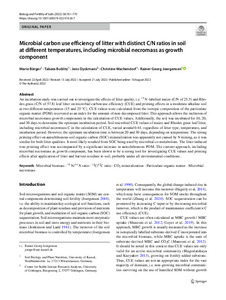| dc.date.accessioned | 2022-10-12T12:50:19Z | |
| dc.date.available | 2022-10-12T12:50:19Z | |
| dc.date.issued | 2022-08-10 | |
| dc.identifier | doi:10.17170/kobra-202209226891 | |
| dc.identifier.uri | http://hdl.handle.net/123456789/14186 | |
| dc.description.sponsorship | Gefördert im Rahmen des Projekts DEAL | ger |
| dc.language.iso | eng | eng |
| dc.rights | Namensnennung 4.0 International | * |
| dc.rights.uri | http://creativecommons.org/licenses/by/4.0/ | * |
| dc.subject | microbial biomass | eng |
| dc.subject | ¹⁵ N/¹⁴ N ratio | eng |
| dc.subject | ¹³C/¹²C ratio | eng |
| dc.subject | CO₂ mineralization | eng |
| dc.subject | particulate organic matter | eng |
| dc.subject | microbial necromass | eng |
| dc.subject.ddc | 570 | |
| dc.title | Microbial carbon use efficiency of litter with distinct C/N ratios in soil at different temperatures, including microbial necromass as growth component | eng |
| dc.type | Aufsatz | |
| dcterms.abstract | An incubation study was carried out to investigate the effects of litter quality, i.e. ¹⁵ N-labelled maize (C/N of 25.5) and Rhodes grass (C/N of 57.8) leaf litter on microbial carbon use efficiency (CUE) and priming effects in a moderate alkaline soil at two different temperatures (15 and 25 °C). CUE values were calculated from the isotopic composition of the particulate organic matter (POM) recovered as an index for the amount of non-decomposed litter. This approach allows the inclusion of microbial necromass growth components in the calculation of CUE values. Additionally, the soil was incubated for 10, 20, and 30 days to determine the optimum incubation period. Soil microbial CUE values of maize and Rhodes grass leaf litter, including microbial necromass C in the calculation of CUE, varied around 0.61, regardless of litter type, temperature, and incubation period. However, the optimum incubation time is between 20 and 30 days, depending on temperature. The strong priming effect on autochthonous soil organic carbon (SOC) mineralization was apparently not caused by N mining, as it was similar for both litter qualities. It most likely resulted from SOC being used by microbial co-metabolism. The litter-induced true priming effect was accompanied by a significant increase in autochthonous POM. The current approach, including microbial necromass as growth component, has been shown to be a strong tool for investigating CUE values and priming effects after application of litter and harvest residues to soil, probably under all environmental conditions. | eng |
| dcterms.accessRights | open access | |
| dcterms.creator | Börger, Marie | |
| dcterms.creator | Bublitz, Tabata | |
| dcterms.creator | Dyckmans, Jens | |
| dcterms.creator | Wachendorf, Christine | |
| dcterms.creator | Jörgensen, Rainer Georg | |
| dc.relation.doi | doi:10.1007/s00374-022-01656-7 | |
| dc.subject.swd | Biomasse | ger |
| dc.subject.swd | Bodenchemie | ger |
| dc.subject.swd | Kohlenstoff | ger |
| dc.subject.swd | Mineralisation | ger |
| dc.subject.swd | Partikulärer organischer Stoff | ger |
| dc.subject.swd | Streu | ger |
| dc.type.version | publishedVersion | |
| dcterms.source.identifier | eissn:1432-0789 | |
| dcterms.source.issue | Issue 7 | |
| dcterms.source.journal | Biology and Fertility of Soils | eng |
| dcterms.source.pageinfo | 761-770 | |
| dcterms.source.volume | Volume 58 | |
| kup.iskup | false | |


